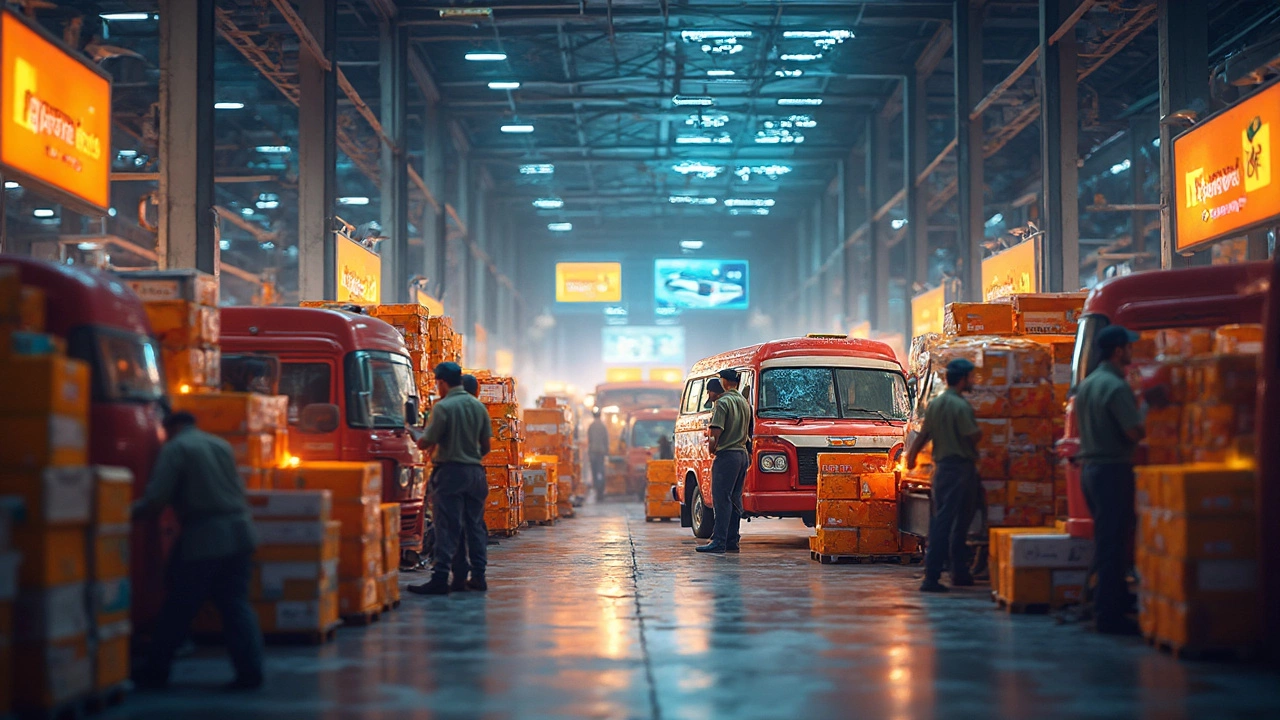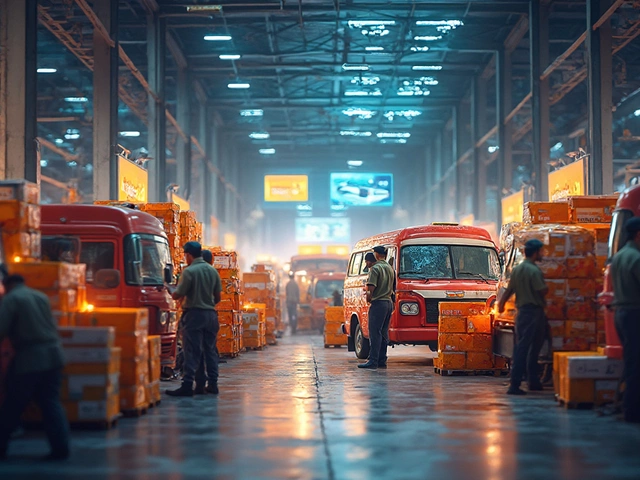Ever wonder how you can buy a smartphone at midnight and get it delivered to your door two days later? That’s e-commerce in action—just people buying and selling stuff over the internet, with logistics working like the invisible engine in the background. E-commerce only looks easy on your screen. Behind every quick delivery, there’s a whirlwind of planning, warehouses, shipping, and a lot of tech quietly making it all run.
People sometimes think e-commerce is just big names like Amazon. But any shop with an online checkout button counts—whether it’s a local bookshop, a global gadget store, or your neighbor selling crafts. Logistics, in this world, isn’t just a buzzword. It’s all the steps that happen from the second you click ‘buy’ to the moment that package lands on your doorstep. If you’ve ever tracked a parcel online, you’ve watched e-commerce logistics do its thing in real time.
- The Basics of E-commerce
- How Logistics Powers E-commerce
- Real Examples from Online Stores
- Tips for Streamlining Your E-commerce Logistics
The Basics of E-commerce
When people talk about e-commerce, they mean any kind of buying or selling done online. It doesn’t matter if you’re ordering sneakers from a huge retailer or purchasing a single book from a small indie shop’s website—if it’s happening over the internet, it’s e-commerce.
There are a few common types of e-commerce you might see:
- B2C (Business-to-Consumer): Stores selling directly to you. Think of major names like Amazon, or even that local bakery with an online order page.
- B2B (Business-to-Business): Companies selling to other companies. For example, an office supply site where businesses bulk order paper and pens.
- C2C (Consumer-to-Consumer): People selling to other people, usually through platforms like eBay or Facebook Marketplace.
- C2B (Consumer-to-Business): Less common, but happens when individuals sell goods or services to companies, like photographers licensing stock photos to a brand.
The entire e-commerce process relies on a few major things: a website or app where shopping happens, a secure payment system, an order management setup, and logistics to get stuff from A to B. The more seamless the system, the better the customer experience.
People are shopping online more than ever. Recent data from Statista shows global online shopping sales hit over $6 trillion in 2024. That number is only climbing, which means e-commerce isn’t just the future—it’s the now.
| Year | Global E-commerce Sales (USD) |
|---|---|
| 2022 | $5.2 trillion |
| 2023 | $5.8 trillion |
| 2024 | $6.3 trillion |
What does all this mean for businesses and shoppers? As more stores move online, there are more choices for everyone. But fast, reliable logistics and a smooth website are crucial—you won’t keep shoppers happy if packages arrive late or checkouts are buggy.
How Logistics Powers E-commerce
Without solid logistics, e-commerce would crash and burn. It’s what gets your shoes from an online store in one city to your front step across the country—sometimes overnight. For most online businesses, logistics covers a chain of stuff: warehousing, picking and packing, shipping, last-mile delivery, and even handling returns.
Think about Amazon Prime’s two-day delivery promise. It works because they’ve set up a huge network of warehouses (they call them fulfillment centers) and teamed up with delivery services around the world. But it’s not just the big players. Even small web shops use logistics tricks to speed up shipping—like choosing fulfillment hubs near customers or using software that picks the fastest delivery route.
Here’s what usually happens when you place an online order:
- Your order goes straight to a warehouse (sometimes run by the retailer, sometimes an outside service).
- Staff or robots pick the product from a shelf.
- It gets packed and labeled for shipping.
- A courier—UPS, FedEx, or maybe the shop’s own van—picks it up and delivers it to your place.
Logistics also deals with “last-mile delivery,” which is usually the most expensive and tricky part since it means getting your package over that final stretch to your door fast and safe. Some companies now offer same-day delivery, using local drivers—kind of like Uber, but for parcels.
| Step | Avg. Time Taken |
|---|---|
| Order Processing | 2-4 hours |
| Packing | 1-2 hours |
| Shipping | 1-5 days (standard) |
| Last-Mile Delivery | Few hours to 1 day |
If you’re an online seller, remember: reliable order fulfillment is what keeps your customer reviews glowing. People want their purchases on time, and logistics is the reason it happens. Skipping on logistics is one of the quickest ways to lose out in the online shopping game.

Real Examples from Online Stores
If you want to see e-commerce logistics in action, look at companies like Amazon, Walmart, and Shopify sellers. Amazon is famous for its Prime shipping, which means millions of products are shipped fast, often with same-day or next-day delivery. That’s thanks to a huge network of warehouses—over 175 fulfillment centers worldwide—packed with the latest in sorting, robotics, and tracking tech.
Walmart has taken a different route by combining both online and physical stores. When you order a coffee maker on their website, there’s a high chance it’ll be shipped from the store closest to your place, not just some faraway warehouse. This cuts down on shipping times and helps Walmart compete with Amazon on delivery speed. Plus, you can order online and pick up in-store—something a lot of shoppers use if they need something the same day.
Think smaller, too. Many Shopify sellers work with third-party fulfillment centers. Take an independent t-shirt brand, for example. When someone places an order, the fulfillment partner grabs a shirt from their stock, packs it with the right branding, and ships it straight to your door—usually with real-time tracking so customers can watch their package move from warehouse to mailbox. This setup lets small businesses handle thousands of orders without renting their own storage or packing boxes all night long.
If you like numbers, check this out:
| Online Store | Average Orders per Day | Number of Fulfillment Centers | Delivery Speed Options |
|---|---|---|---|
| Amazon | ~1.6 million | 175+ | Same- or next-day |
| Walmart | ~200,000 | Up to 150 U.S. stores used as centers | Same-day pickup, 2-day shipping |
| Shopify (average store) | 50-100 | Third-party, varies | Standard, express (varies) |
The big takeaway? All these stores use logistics to move online orders quickly and keep shoppers happy. Whether you’re shopping from a massive marketplace or a one-person t-shirt shop, there’s an army of warehouse workers, software, and drivers working together to make e-commerce actually work. The goal’s the same for everyone: get stuff to customers, fast and reliably.
Tips for Streamlining Your E-commerce Logistics
If you run an e-commerce store, the way you handle logistics can make or break your business. Fast, reliable shipping keeps customers happy (and coming back), but things can get messy quick if your system isn't up to the task. Let's dig into some key tips that actually work in the real world.
- Automate Order Processing: Don’t waste time juggling orders by hand. Use software that syncs your website, inventory, and packing slips. Tools like ShipStation, ShipBob, or Shopify automations cut down errors and save hours each week.
- Keep Inventory Updated: Real-time inventory tools let you see what's in stock instantly. This avoids the classic nightmare—selling something that’s out of stock. Plenty of platforms offer automated stock updates linked right to your online store.
- Choose the Right Shipping Partners: Not all carriers are created equal. Test delivery times and reliability with USPS, UPS, FedEx, and regional couriers. Sometimes, splitting shipping between multiple partners gives your customers quicker, cheaper options.
- Use Smart Packaging: Size matters. Packages that are just right for your products save on shipping fees and lower the risk of damage. Plus, eco-friendly packaging appeals to your shoppers—two birds with one box.
- Offer Real-Time Tracking: Customers want to see where their order is at all times. Choose logistics systems that send tracking numbers automatically. This cuts down on "where’s my order?" emails and boosts trust.
Here’s how fast shipping expectations have changed, according to 2024 surveys from the National Retail Federation:
| Shipping Speed | Customer Expectation |
|---|---|
| Same Day | 35% |
| 1-2 Days | 48% |
| 3-5 Days | 17% |
Quick takeaway: Almost half of shoppers want their online order in under two days. Staying competitive with online shopping means your logistics game has to be sharp.
Lastly, run small monthly reviews of your whole process. Ask your team, “What’s slowing us down?” Tweak what’s not working. If you’re feeling stuck, talk to other order fulfillment pros—you’d be surprised what you can learn from others in the e-commerce trenches.





